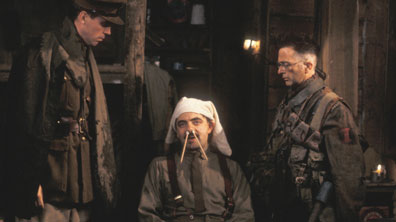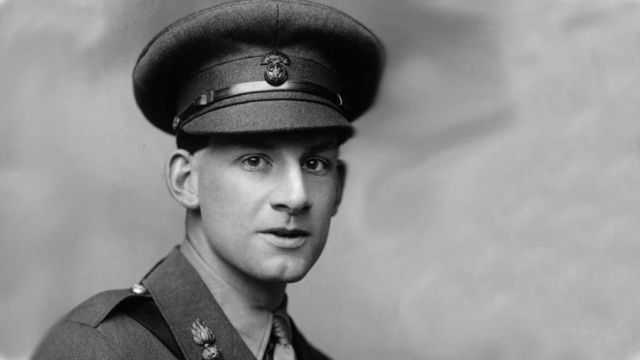‘Easter 1916’
I have met them at close of day
Coming with vivid faces
From counter or desk among grey
Eighteenth-century houses.
I have passed with a nod of the head
Or polite meaningless words,
Or have lingered awhile and said
Polite meaningless words,
And thought before I had done
Of a mocking tale or a gibe
To please a companion
Around the fire at the club,
Being certain that they and I
But lived where motley is worn:
All changed, changed utterly:
A terrible beauty is born.
That woman’s days were spent
In ignorant good-will,
Her nights in argument
Until her voice grew shrill.
What voice more sweet than hers
When, young and beautiful,
She rode to harriers?
This man had kept a school
And rode our winged horse;
This other his helper and friend
Was coming into his force;
He might have won fame in the end,
So sensitive his nature seemed,
So daring and sweet his thought.
This other man I had dreamed
A drunken, vainglorious lout.
He had done most bitter wrong
To some who are near my heart,
Yet I number him in the song;
He, too, has resigned his part
In the casual comedy;
He, too, has been changed in his turn,
Transformed utterly:
A terrible beauty is born.
Hearts with one purpose alone
Through summer and winter seem
Enchanted to a stone
To trouble the living stream.
The horse that comes from the road.
The rider, the birds that range
From cloud to tumbling cloud,
Minute by minute they change;
A shadow of cloud on the stream
Changes minute by minute;
A horse-hoof slides on the brim,
And a horse plashes within it;
The long-legged moor-hens dive,
And hens to moor-cocks call;
Minute by minute they live:
The stone’s in the midst of all.
Too long a sacrifice
Can make a stone of the heart.
O when may it suffice?
That is Heaven’s part, our part
To murmur name upon name,
As a mother names her child
When sleep at last has come
On limbs that had run wild.
What is it but nightfall?
No, no, not night but death;
Was it needless death after all?
For England may keep faith
For all that is done and said.
We know their dream; enough
To know they dreamed and are dead;
And what if excess of love
Bewildered them till they died?
I write it out in a verse –
MacDonagh and MacBride
And Connolly and Pearse
Now and in time to be,
Wherever green is worn,
Are changed, changed utterly:
A terrible beauty is born.
NOTES
Easter 1916 was written in response to the failed uprising of Irish Nationalists against the British government in the week of Easter Sunday 1916. Members of the Irish Republican Brotherhood attempted to take a number of important government buildings in Dublin, trying to start a revolution against a weakened, wartime Britain that would conclude in the foundation of an Irish Free State. The British army defeated the rebels who barricaded the Post Office buildings, and executed the leaders in May 1916. Hundreds were killed during the uprising, and sixteen men were executed after the rebellion, including the four named in the poem. ‘Easter 1916’ was written in September 1916, in response to these huge events.
STRUCTURE: The poem is written in four long stanzas with a simple regular rhyme scheme of ABAB, suitable for an extended narrative poem like this. You’ll note that because this is such a long and complicated poem, I will be analyzing it here stanza by stanza.
W.B. Yeats: Yeats was a proud Irish Republican. While he had qualms about violent rebellion against Britain, he was angered at the execution of the Irish leaders, who he believed had sacrificed themselves for Ireland.
Easter 1916: refers to the date of the rebellion.
Stanza One: This stanza relates the everyday encounters that the poet had with the rebels before the Easter rebellion. It paints a rather dull and disappointing city, and conveys the poet’s casual disregard for those who would become rebels.
“I have met them at the close of day…”: The poem begins by referring to the people Yeats knew or socialized with who were involved in the rebellion. He remembers them walking home from work, “from counter or desk”.
“Polite meaningless words” Those killed were only acquaintances of Yeats, and he did not get on well with all of them. Note the repetition of this line: as if to emphasise the everyday nature of their exchanges.
“a mocking tale or a gibe”: Yeats remembers that he often thought of his encounters with the nationalists only as an opportunity to scorn them to closer friends.
“Being certain that they and I / But lived where motley is worn”: ‘motley’ is the quarter-coloured dress of jesters or fools. Yeats plainly had a low opinion of the seriousness of his Irish contemporaries.
“All changed, changed utterly / A terrible beauty is born”: the poem’s famous and dramatic refrain, like an epitaph for the dead rebels, and the Ireland that once was. The words promise a painful birth for the new Ireland because of the rebels’ actions.
Stanza Two: This stanza writes of those actually involved in the rebellion, and Yeat’s own memories and opinions of the dead.
“That women’s days were spent in ignorant good will…”: referring to Countess Georgina Markiewicz, an upper class socialite and nationalist, later a cabinet minister in the Irish Free State (1922). Yeats clearly thought her superficial (“ignorant good will”) and loudly argumentative (“shrill”). She was however once, he remembers, beautiful. Is this a sexist judgement? Markiewicz escaped execution by the British, unlike the three men mentioned following.
“This man”: this refers to Patrick Pearse, a central figure in the Easter rebellion and in Irish nationalism generally. Pearse founded a school, St. Edna’s: hence he “kept a school”.
“This other his helper”: this is Thomas MacDonagh, who was Pearse’s assistant headmaster at St. Edna’s. McDonagh was a promising poet and playwright who Yeats plainly admired: “He might have won fame in the end”.
“This other man… vainglorious lout”: John MacBride, who married Maud Gonne, a woman whom Yeats was inspired and obsessed by. MacBride beat Gonne during their marriage and ultimately left her, hence the mention of “most bitter wrong / To some… near my heart”. Nonetheless, Yeats must name or “number him” in the poem. It is a mark of the power of the transformation that Easter 1916 has caused, Yeats seems to suggest that “He, too” (twice repeated) “has been changed in his turn”, or the part he played in the rebellion.
Stanza Three: This stanza is more abstract than the other more literal stanzas. It introduces the symbol of a stone in an ever-moving stream. The symbol of the stone in this stanza can be interpreted in a number of ways. Symbols are not allegorical figures to which we can point and say, ‘This means exactly this’. It is in the nature of symbols to be ambiguous, multivalent (meaning they invite many interpretations), and rich in meaning. My reading of precisely what the symbol of the stone means must be limited, therefore: governed by my own interpretive limitations and the limited purpose of these study notes.
“Hearts with one purpose alone…”: Yeats moves from considering the rebels to a more philosophical consideration of those who determine on one purpose in life. These people, through the changing seasons, Yeats suggests “seem / Enchanted to a stone / To trouble the living stream.” The first interpretation offered here is that this constant stone represents the Nationalist rebels’ steadfastness and determined purpose amidst the rapid change of life. Yet this stone might also conceivably represent the British state too, and hearts that have been turned to stone and “trouble the living stream” of Irish life. However, this stone could also be taken as a broader symbol of determined purpose amidst change. This may have positive connotations, such as toughness, a determined nature, constancy and truth; or negative associations, such as immobility, inflexibility, insensitivity.
“Minute by minute they change…”: A man rides his horse by the stream, while birds fly about, beneath a rapidly moving sky (“cloud to tumbling cloud”); these are all symbols of movement, of change. The detail of the poem here seems to involve a slow consideration of the tiniest detail, that mimics a subjective slowing of the mind, emphasised in the repetition of “minute by minute they live”.
“The stone’s in the midst of all.”: The stanza returns to this mysterious and enigmatic stone, whose persistence seems to speak to the poet. Is it possible that Yeats also associates the stone with Ireland itself, as an immovable nation, unmoved by the actions of those such as Pearse, McDonagh and MacBride?
Stanza Four: The final stanza reflects on the sacrifice of the men; whether it was necessary; and the purpose of writing the poem.
“Too long a sacrifice / Can make a stone of the heart.”: This is again an ambiguous phrase, but seems to allude to the long struggle and continuing sacrifice of the Irish, and how it hardens the heart. Yeats, remember, struggles against this callousness himself when considering the dead.
“O when may it suffice?”: or, ‘When will this sacrifice be enough?’— almost a cry to God, or “Heaven’s part”.
“our part / to murmur name on name / As a mother names her child”: the poet speaks of what the duty of the Irish (“our part”) is to the dead men. The act of remembering the dead should be compared to the familiar repetition of a mother repeating the name of a child. The mother bears comparison to Ireland itself, as the refrain “a terrible beauty is born” suggests.
“Was it needless death after all? / For England may keep faith”: the thought strikes the poet that the deaths of the men may have been unnecessary. In 1914 a Home Rule bill had been passed that had made provisions for Irish self-governance in Dublin. This was, nonetheless, the latest of a string of promises of home rule that had been postponed or unkept.
“We know their dream; enough / To know they dreamed and are dead”: Yeats puts aside doubts, asserting that the dream of the Nationalists is known to all the Irish (“We”) and that the men are dead because of these dreams. It does not matter if they acted rashly (“What if…?” means ‘what does it matter if?’).
“Now and in time to be, / Wherever green is worn / Are changed, changed utterly”: in actually invoking the names of “MacDonagh and MacBride / And Connolly and Pearse” the poem assumes an old role, that of the poem of remembrance of glorious death and sacrifice in war. The men will be remembered by the Irish nation for as long as the nation is celebrated and its colours worn.
[ANTHOLOGY NOTE: This poem in fact contrasts with the message of Yeat’s first poem and is thus an interesting juxtaposition: it deals with the acts of “statesmen” and politics, and is an interesting non-British voice in the anthology. This poem by Yeats (and ‘Sixteen Dead Men’) sit uneasily with the rest of the collection, in terms of the AQA AS exam. They are not strictly First World War literature; they are products of an Irish uprising against the British state that took place during the First World War. It is unlikely that either will ever feature in the exam, and if they do, students will be entitled to an insurrection against the AQA Examiners Office on a similar scale to the events of 1916.]









